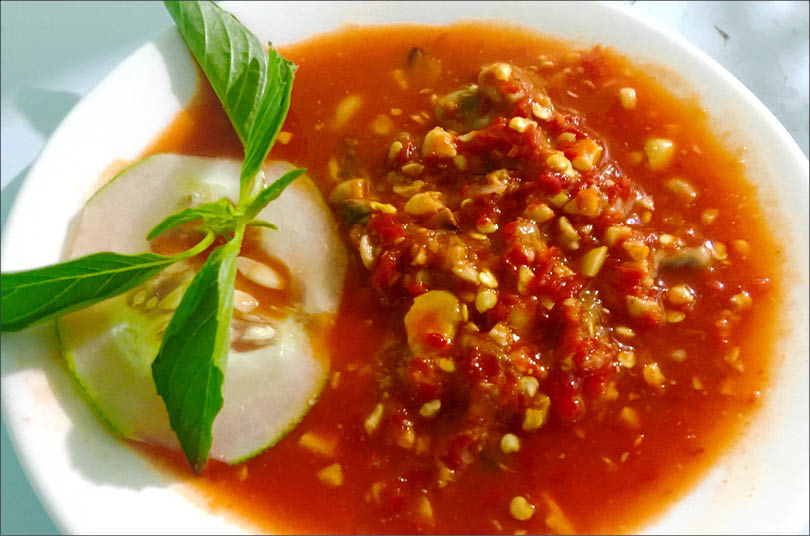Natural oyster is one among the varieties of seafood that Nature bestows on the folk living by the side of Tam Giang Lagoon. From mid-December (Lunar calendar) when the water level in the lagoon drops low, that is, when the tides are lowest, fishermen on small boats run with the currents to collect oysters attaching themselves on coast cliffs.

Fermented oyster, a kind of dipping sauce, cheap but not to be found everywhere
I did have a chance to join the fishermen in Huong Phong Commune, Huong Tra Town, to fumble for oysters on the cliffs when it was still dark. What hard work! To put it simply, an oyster collector should equip himself with a hand net and a knife and runs the boat to shallow waters looking for young oysters surfacing on cliffs. Then he prises oysters off the rock with their knives to collect them.
Fishermen finish the catch and come ashore when the tides rise. Oysters are then given to other members in the family to remove their shells. It is such hard work; but then it brings them pretty high earnings for the people.
With many people, oysters are more often than not associated with familiar, popular dishes such as oyster grilled with spring onion, oyster porridge, raw oyster with mustard, oyster steamed with lemongrass, etc. Oysters can also be processed into more luxurious dishes such as oyster baked with cheese, oyster spaghetti, etc. However, to the fishermen living by the lagoon, fermented oyster for all time stands out with its typical characteristics reminding them of their wandering life.
Oysters have their own season; so does fermented oyster, of course. And actually not many people can make this type of sauce. After shells are removed, one picks out not-too-big oysters, washes them clean and wait for them to dry up. They then mix the oysters with proportional amounts of salt, chili powder, fresh chili, peanut, wine, galangal, etc. The mixture is then bottled. About more than one week later, when the mixture turns bright red with oysters floating to the surface, it is then ready to eat.
It sounds that simple but according to Mrs. No in Loc Binh Commune, Phu Loc District, to make good fermented oyster, one should be quite skillful. The use of spices must be well regulated so that the obtained sauce still keeps the original taste of the oyster.
“Oysters appear in the lagoon from December to July (Lunar calendar) and the material for this dish must be natural oysters. Collecting oysters is already hard work, so the fishermen often sell them for money instead of keeping them for making fermented oyster, which requires complicated processing of various steps. “I make it to order only. Though fermented oyster is made similarly as to the cases of other kinds of fermented foods with fish, to get a not-too-sour sauce and keep the original flavor of the oyster is not simple at all,” said Mrs. No.
To enjoy the dish, diners are to pick up the oysters floating on top with chopsticks, put them into a bowl, then pour some of the sauce on. And as they would have it, some garlic, chili, lime juice, sugar, monosodium glutamate may be mixed in to add to the taste of the food.
Fermented oyster is not a popular dish. Along the routes near the lagoon, now and then, one might see bottles of fermented oyster on display, which are sold at a very cheap price (VND30.000-35.000 per bottle). This sauce goes well with pork. They will make up a combination with the sweet taste of oyster, the sour and hot taste of lime, garlic and chili, the salty taste of the sauce and the fatty taste of pork. It also tastes delicious with a bowl of hot rice.
Story and photo: Le Tho